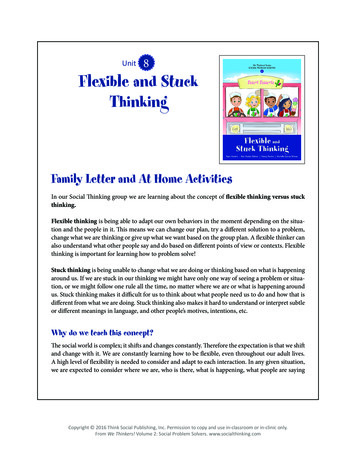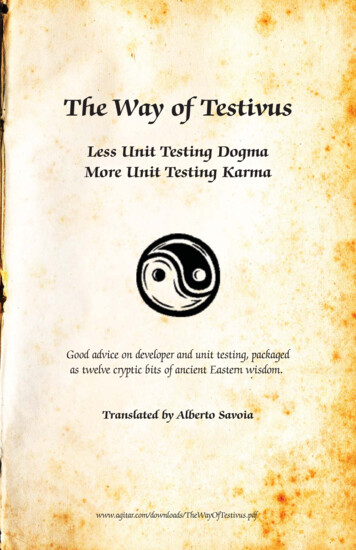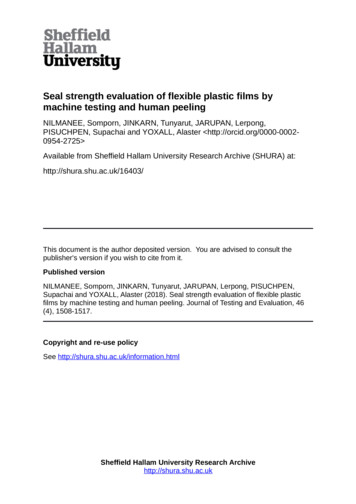
Transcription
Unit8Flexible and StuckThinkingFamily Letter and At Home ActivitiesIn our Social Thinking group we are learning about the concept of flexible thinking versus stuckthinking.Flexible thinking is being able to adapt our own behaviors in the moment depending on the situation and the people in it. This means we can change our plan, try a different solution to a problem,change what we are thinking or give up what we want based on the group plan. A flexible thinker canalso understand what other people say and do based on different points of view or contexts. Flexiblethinking is important for learning how to problem solve!Stuck thinking is being unable to change what we are doing or thinking based on what is happeningaround us. If we are stuck in our thinking we might have only one way of seeing a problem or situation, or we might follow one rule all the time, no matter where we are or what is happening aroundus. Stuck thinking makes it difficult for us to think about what people need us to do and how that isdifferent from what we are doing. Stuck thinking also makes it hard to understand or interpret subtleor different meanings in language, and other people’s motives, intentions, etc.Why do we teach this concept?The social world is complex; it shifts and changes constantly. Therefore the expectation is that we shiftand change with it. We are constantly learning how to be flexible, even throughout our adult lives.A high level of flexibility is needed to consider and adapt to each interaction. In any given situation,we are expected to consider where we are, who is there, what is happening, what people are sayingCopyright 2016 Think Social Publishing, Inc. Permission to copy and use in-classroom or in-clinic only.From We Thinkers! Volume 2: Social Problem Solvers. www.socialthinking.com
and doing around us, how they are feeling, what they might be thinking, and adjust our plan andbehavior accordingly. A challenge in any of the above listed area can lead to getting “stuck” or havingstuck thinking.When a child gets “stuck” or rigid in his or her thinking, it can be helpful to pause and examine thepossible roots of the problem, based on the child and situation. While it could be that a child is stuckthinking about his or her own plan (because the child doesn’t want to stop a preferred activity to followthe group plan), there are also alternative explanations. Sometimes a child has a hard time figuring outthe group plan to begin with. Other times, he or she may observe and understand what the group planis but doesn’t know what to do or how to be part of that plan. The visual below illustrates this concept:I’m stuck!I don’t see any plan atall! I see objects aroundme and I struggle to payattention to people.I don’t knowthe group plan.I know the group planbut don’t know howto get myself startedor involved in it.I know the group planbut want to follow myown plan.How you might support your child in these rigid thinking moments may depend upon why he orshe is stuck in the first place! Do not assume that your child is simply being oppositional or stuck onwhat he or she wants to do. It is often times the case that the child doesn’t know what to do instead!Where do we start?Teaching flexibility first starts with understanding there are choices, options and different ways tolook at a situation. You can only be flexible when you see you have choices. This helps with problemsolving as well. When children are able to generate and then make choices, they learn they have somecontrol over their environment. This helps them learn to feel more comfortable in situations whichrequire change. This can, at times, calm their frustrations, reduce challenging behaviors, and motivatethem to participate more in activities or routines.Copyright 2016 Think Social Publishing, Inc. Permission to copy and use in-classroom or in-clinic only.From We Thinkers! Volume 2: Social Problem Solvers. www.socialthinking.com
In the story we read, Flexible and Stuck Thinking: Ice Cream Shop Adventure, the four characters Evan,Ellie, Jesse and Molly play ice cream shop. Their adventure begins when Mr. Roadrunner calls in anorder for a five scoop ice cream cone delivery. Initially the children get stuck on following their ownplans, wanting to go first, etc. and all of the ice cream melts before they can get it to Mr. Roadrunner.The children learn that they have to use flexible thinking to work together and deliver the cone beforeall the ice cream melts. Using flexible thinking makes everyone feel good and helps everybody be partof the group plan.Activities to try at home1. Teaching flexibility first starts with understanding that there are choices. Play a game togetherwhere the goal is to think of as many ideas and options as possible. Here are some suggestions toget you started: Things to eat for breakfast/lunch/dinner/snack/dessert Colors of shirt/pants/shoes/jackets/etc. to wear Toppings on a pizza (cheese, mushrooms, pepperoni, olives, pineapple, sausage, etc.) Animals to visit at the zoo (elephants, lions, giraffes, monkeys, zebras, bears, tigers, hippos,rhinos, flamingos, etc.) Animals we could see on a farm (cows, chickens, pigs, sheep, ducks, horses, dogs, etc.) Pets a person could have (dog, cat, fish, hamster, turtle, lizard, etc.) Books we could read at bed time (fill in with ideas from your own library) Ways to move across a room (run, jump, crawl, hop, skip, tiptoe, etc.) Ways to travel (car, plane, train, boat, helicopter) Ways to get dressed (socks first, last, in the middle; shirt then pants, pants then shirt; jacketfirst? No, then we can’t put on a shirt! We can be flexible with some parts of getting dressed.With others we have to follow the plan (undies before pants; shirt before jacket/sweater; socksbefore shoes)The goal of this activity is to provide positive feedback and send the message that your child CANbe flexible. (“Wow, you were so flexible thinking of all of those ideas!”) Model the vocabulary andreinforce your child’s efforts to be flexible as much as possible. (“I know you like to go first in thegame and I noticed you let your sister go first instead. Good job being flexible!”) The more children hear this, the more they can start to understand and think of themselves as flexible thinkers.Copyright 2016 Think Social Publishing, Inc. Permission to copy and use in-classroom or in-clinic only.From We Thinkers! Volume 2: Social Problem Solvers. www.socialthinking.com
2. Use the vocabulary “flexible thinking” and “stuck thinking” throughout your daily activities androutines. Keep in mind that any time two people are sharing space, they are considered a group.And when people are in a group, flexible thinking is expected! You can use the vocabulary whenyou and your child are alone, or when the family is together as a whole.3. Highlight naturally occurring times when you (as the caregiver) are using flexible or stuck thinking. It’s important for your child to understand that you are constantly being challenged to useflexible thinking too. Consider the following examples and how you might talk out loud throughthe situation: “My plan today was to take a walk outside. Then, I remembered I had to go to a meeting atschool. I had to be flexible and change my plan.” “My brain is stuck thinking about wanting to read a good book. But it’s time to wash dishes.I have to be flexible because the kitchen needs to be cleaned first.”4. Reinforce times when you observe your child using flexible thinking. While it’s much easier tocatch your child in a stuck moment, it’s important to set a positive tone with this vocabulary. Inour experience, when children hear they are using stuck thinking over and over they start to attach negative feelings to the terms. By contrast, if the flexible moments are highlighted, they feelinitial success and will be more open to learning about the stuck moments later on. Consider thefollowing examples: “Wow, you changed your plan! That was so flexible!” “I am so proud of your flexible thinking! I could tell you wanted to ride your bike, but youwere flexible and ate lunch first.” “I know you wanted the blue game piece but there is only green left. Let’s use our flexiblethinking!” “You were so flexible giving your brother a choice of what movie to watch. That makes mefeel happy! Now we can start movie time.”Flexible Brain ChallengeA flexible learning activity you can do with your child1. First tell your child, “We are going to practice being flexible. Get ready to follow my plan!” Forexample: instruct your child to jump 10 times. As the child begins to jump, say “Never mind, Ichanged the plan. Sit down instead!”2. Give positive reinforcement when your child is flexible and changes his/her actions. For example: “You were so flexible, Silvia. You sat down right away when the plan changed. Great flexiblethinking!”Copyright 2016 Think Social Publishing, Inc. Permission to copy and use in-classroom or in-clinic only.From We Thinkers! Volume 2: Social Problem Solvers. www.socialthinking.com
3. Follow the same process describe above for two or three more activities. Some suggestions include: “Put your hands on your head. Now put them on your hips.” “Clap your hands 50 times. Never mind, only 10!” “Do jumping jacks with me. Never mind, let’s do arm circles instead.”4. If possible, use video! As you do this activity, videotape your child. Play the video back to watchso your child can see how well he or she is doing being flexible! Heap on the praise when yourchild is using flexible thinking!*The storybook mentioned in this letter is part of Social Problem Solvers, Volume 2 of the We Thinkers! series,our Social Thinking early learner curriculum. Volume 1 (Social Explorers) and Volume 2 each consist of fivestorybooks that introduce social concepts through a themed adventure, and a curriculum book with units,activities and tips to teach the concepts. A music CD, The Incredible Flexible You, supports the curriculumwith 12 songs, each of which relate directly to the Social Thinking Vocabulary concepts introduced in the twovolumes. It’s not necessary to purchase any of these materials to work with your child on these concepts athome. The Family Letters share basic information and vocabulary and suggest some at-home activities. Also,there are many free articles on the Social Thinking website that describe the core philosophy of Social Thinking(www.socialthinking.com).The music CD and each set of five storybooks are sold separately from the curriculum, should you like to extendyour child’s learning at home. Parents purchasing either the storybook set(s) or the music CD for at-home use areeligible to enter discount code “storybooks10” at checkout to receive 10% off the retail price of those products.NOTE: Volume 1 of We Thinkers! was previously released under the name, The Incredible Flexible You. The namewas changed in early 2016, however the content in all materials in Volume 1 remained the same.Copyright 2016 Think Social Publishing, Inc. Permission to copy and use in-classroom or in-clinic only.From We Thinkers! Volume 2: Social Problem Solvers. www.socialthinking.com
flexible thinking too. Consider the following examples and how you might talk out loud through the situation: “My plan today was to take a walk outside. Then, I remembered I had to go to a meeting at school. I had to be flexible and change my plan.” “My brain is stuck thinking










